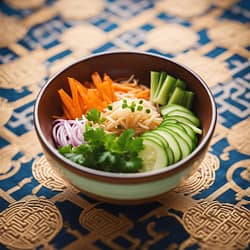
Traditional Fermented Kimchi Salad
Enjoy your homemade kimchi with rice, in stews, or as a side dish to add a flavorful, probiotic-rich kick to any meal! Remember, the longer it ferments, the more pronounced the flavors will become. At least 2 days fermenting time.
Equipment
- 1 Large mixing bowl
- Measuring Cups
- Spoons
- 1 Cutting board
- 1 Chef's knife
- 1 Large Jar or Airtight Container
- 1 Colander
- 1 Plate
- 1 Something heavy like a jar or rock for weighing down
Ingredients
- 1 medium Napa cabbage about 2 pounds
- 1/4 cup sea salt or kosher salt
- Water enough to cover the cabbage
- 1 tablespoon grated garlic about 5-6 cloves
- 1 teaspoon grated ginger
- 1 teaspoon sugar
- 3-4 tablespoons seafood flavor or water optional, can use kelp or mushroom broth for a vegan option
- 1-5 tablespoons Korean red pepper flakes gochugaru to taste
- 8 ounces Korean radish or daikon peeled and cut into matchsticks
- 4 scallions trimmed and cut into 1-inch pieces
- 1 medium carrot peeled and cut into matchsticks (optional)
Instructions
- Begin by preparing the cabbage. Slice the Napa cabbage in half lengthwise, then cut it into quarters. Remove the cores and chop the cabbage into bite-sized pieces.
- In your large mixing bowl, sprinkle the salt over the chopped cabbage and use your hands (with gloves if you prefer) to massage the salt into the cabbage until it starts to soften a bit. Then add water to cover the cabbage. Place a plate on top and weigh it down with something heavy. Let the cabbage soak in the saltwater for 1-2 hours.
- While the cabbage is soaking, you can prepare the spice paste. In a separate bowl, combine the grated garlic, grated ginger, sugar, and seafood flavor or water. Mix in the Korean red pepper flakes, starting with the lower amount and adding more to reach your desired level of heat.
- Once the cabbage has finished soaking, rinse it thoroughly under cold water a few times. Drain in a colander and set aside to let the excess water drain off, about 15 to 20 minutes.
- Meanwhile, prepare your other vegetables by cutting the Korean radish (or daikon), scallions, and carrot, if you're using it, into matchsticks.
- Gently squeeze any remaining water from the cabbage and then combine it with the spice paste. Add the radish, scallions, and carrots. Use your hands (again, gloves are helpful) to thoroughly mix and massage the paste into the vegetables until they are well coated.
- Pack the kimchi into the jar or airtight container, pressing down on it until the brine rises to cover the vegetables. Leave at least 1 inch of space at the top. Seal the jar with the lid.
- Let the jar stand at room temperature for 1-5 days. You may see bubbles inside the jar and brine may seep out due to the fermentation process; this is normal.
- Check the kimchi once a day, pressing down on the vegetables with a clean spoon to keep them submerged under the brine. When the kimchi tastes ripe enough for your liking, transfer the jar to the refrigerator. You may eat it right away, but it's best after another week or two.